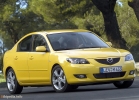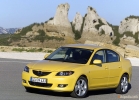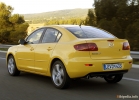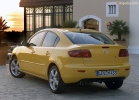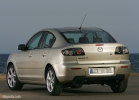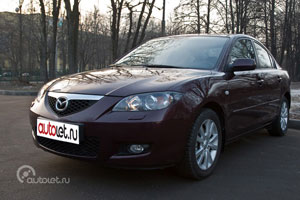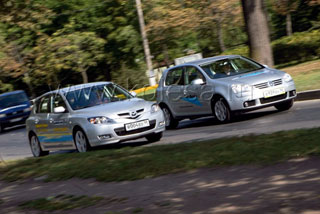Test drive Mazda Mazda 3 (Axela) Sedan 2004 - 2009 sedan
Is Troyak bad?
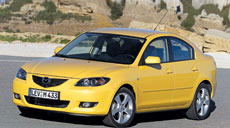 Everyone, even the most unlucky, sometimes smiles good luck. The same is fully applied to automakers: often they shoot past, but almost every company has very successful products on the account. However, the magnificent hits of ten in a row are very rare. And this is exactly what the Japanese company Mazda surprised at the beginning of the decade.
Everyone, even the most unlucky, sometimes smiles good luck. The same is fully applied to automakers: often they shoot past, but almost every company has very successful products on the account. However, the magnificent hits of ten in a row are very rare. And this is exactly what the Japanese company Mazda surprised at the beginning of the decade.  At first, an interesting, with a high level of consumer qualities of Mazda 6, which replaced not only the 626 GF mainstream, but also the image model of Xedos 6 (as you know, after it was discontinued in 2000, it did not have a successor and not appeared). Then, in 2003, the 323rd model changed the compact treshka. Despite the fact that the machine combines a sports sider character with an aggressive design, it does not have many fundamental differences from its predecessor. But this in no case applies to the appearance of the nesting doll: the design made in the new corporate identity of the Japanese company is quite harmonious and moderately evoked. It is unfortunate that the assortment of the body of the body is so scarce: in addition to the four -door sedan, there is only a hatchback with five doors (there was no three -door version). Note that the Japanese have worked well on passive safety: experts argue that the deformation with a wide variety of blows is extremely correct, the salon cell is extremely durable, and the airbags (even specimens with inflatable lateral
At first, an interesting, with a high level of consumer qualities of Mazda 6, which replaced not only the 626 GF mainstream, but also the image model of Xedos 6 (as you know, after it was discontinued in 2000, it did not have a successor and not appeared). Then, in 2003, the 323rd model changed the compact treshka. Despite the fact that the machine combines a sports sider character with an aggressive design, it does not have many fundamental differences from its predecessor. But this in no case applies to the appearance of the nesting doll: the design made in the new corporate identity of the Japanese company is quite harmonious and moderately evoked. It is unfortunate that the assortment of the body of the body is so scarce: in addition to the four -door sedan, there is only a hatchback with five doors (there was no three -door version). Note that the Japanese have worked well on passive safety: experts argue that the deformation with a wide variety of blows is extremely correct, the salon cell is extremely durable, and the airbags (even specimens with inflatable lateral  curtains) always work clearly and on time. Another thing is that repairs, even with a slight accident, will cost a very decent amount. The parts of the body are quite expensive, while many are extremely fragile. For example, the so -called TV, which holds the bumper and headlights in place, is not metal, but plastic.
curtains) always work clearly and on time. Another thing is that repairs, even with a slight accident, will cost a very decent amount. The parts of the body are quite expensive, while many are extremely fragile. For example, the so -called TV, which holds the bumper and headlights in place, is not metal, but plastic. In addition, although Mazda 3 has a normal resistance to corrosion, claims to the quality of the paintwork of early cars, nevertheless, were (in some places, for example, on the rear racks and wheel arches, the paint was swollen and red ulcer formed).
Some characteristics
Type of body
Sedan / hatchback
Stream of doors
4 / 5
Summer places
5
Length
4420 /4490 mm
Width
1755 mm
Height
1465 mm
Wheelbase
2640 mm
Ground clearance
150 mm
Acceleration to 100 km / h*
9 p
Maximum speed*
208 km / h
* Data for a sedan with a 2 l engine.
The interior of the threek favorably distinguishes it from the predecessor: it contains sports, chic, and color (the previous model had a gray salon made of unimportant finishing materials). Plus a decent ergonomics, a comfortable driver's place. A treshka cannot be called a budget car, although sometimes you have to doubt it. So, individual machines have openly poor equipment, there are not even electric windows at the back. However, there are very richly equipped cars.
 One feature related to the standard musical installation should be noted: in the early machines, the head device is combined with the climate control unit. As a result, it is impossible to change the full-time head, otherwise the climate control display will stop displaying information about the temperature and operating modes (though some do not want to change anything, since factory music does not sound so badly). Later, climate control and the music was divided, which a little easier the life of music lovers. Of other shortcomings, mediocre sound insulation should be called.
One feature related to the standard musical installation should be noted: in the early machines, the head device is combined with the climate control unit. As a result, it is impossible to change the full-time head, otherwise the climate control display will stop displaying information about the temperature and operating modes (though some do not want to change anything, since factory music does not sound so badly). Later, climate control and the music was divided, which a little easier the life of music lovers. Of other shortcomings, mediocre sound insulation should be called.  Driving properties are what Mazda 3 (and at the same time, by the way, is a six) special car. Conduct a continuous pleasure: it has acute, accurate controllability (as a result, not the highest riding comfort, the suspension is harsh) and good brakes (although not excessive, but quite correspond to the temperament of a third). At height and speaker: a base car with a 1.6 -liter engine rides normally, two -liter versions are completely assertive. But there is also a sports modification of the MPS, which is driven by a 2.3-liter 260-horsepower turbo engine: it steer perfectly and slows down excellently and accelerates powerfully, and in addition it is much less than car similar in terms of high-speed potential.
Driving properties are what Mazda 3 (and at the same time, by the way, is a six) special car. Conduct a continuous pleasure: it has acute, accurate controllability (as a result, not the highest riding comfort, the suspension is harsh) and good brakes (although not excessive, but quite correspond to the temperament of a third). At height and speaker: a base car with a 1.6 -liter engine rides normally, two -liter versions are completely assertive. But there is also a sports modification of the MPS, which is driven by a 2.3-liter 260-horsepower turbo engine: it steer perfectly and slows down excellently and accelerates powerfully, and in addition it is much less than car similar in terms of high-speed potential.  Now about operation. There are three engines, as we already understood: with a volume of 1.6 (105 hp), 2 (150 hp) and 2.3 l (260 l.). There are three -luminous three -l with an anemic motor with a volume of 1.4 liters, but this model was never officially supplied to Russia. There are no special claims to power units, they are all quite reliable (in any case, atmospheric ones, the turbo engines for conducting statistics are still not enough). It’s just that the motors (especially the most compact volume of 1.6 liters) are extremely demanding of the quality and amount of oil in the crankcase (from time to time you need to check the level), as well as for the frequency of replacement: more than 9 thousand km on one and one It is not recommended to drive the same oil. If you forget about the lubrication in the engine, the latter can be very much offended: the result of the master's neglect will be the fallen compression with subsequent major repairs. Repair is meant not at all the replacement of the rings and the use of sleeves: the block with the pistons will have to be changed assembly, and this is more than 100 thousand in vain of the rubles spent (in vain because only the lazy owner, who does not care about his car, can bring the engine to such a state. ).
Now about operation. There are three engines, as we already understood: with a volume of 1.6 (105 hp), 2 (150 hp) and 2.3 l (260 l.). There are three -luminous three -l with an anemic motor with a volume of 1.4 liters, but this model was never officially supplied to Russia. There are no special claims to power units, they are all quite reliable (in any case, atmospheric ones, the turbo engines for conducting statistics are still not enough). It’s just that the motors (especially the most compact volume of 1.6 liters) are extremely demanding of the quality and amount of oil in the crankcase (from time to time you need to check the level), as well as for the frequency of replacement: more than 9 thousand km on one and one It is not recommended to drive the same oil. If you forget about the lubrication in the engine, the latter can be very much offended: the result of the master's neglect will be the fallen compression with subsequent major repairs. Repair is meant not at all the replacement of the rings and the use of sleeves: the block with the pistons will have to be changed assembly, and this is more than 100 thousand in vain of the rubles spent (in vain because only the lazy owner, who does not care about his car, can bring the engine to such a state. ).  Mazda took the place of Honda in the market, yes, but the quality of service is now at a level, characteristic just for Honda.
Mazda took the place of Honda in the market, yes, but the quality of service is now at a level, characteristic just for Honda. The vast majority of treshki are equipped with mechanical gearboxes, machine guns are found only in versions with a base 1.6-liter engine, more powerful MPS and two-liter motor
cars are equipped exclusively by the manual transmission. Well, as they say, get a car with a sports slope and sign. Agree, it is nice that the boxes are reliable: the servicemen will not remember that they fail.
What about the suspension? The owners do not complain. Neither the bearings of the hubs, nor the racks with the bushings of stabilizers, nor the levers, nor the shock absorbers present surprises and go, if not forever, then for a very long time (extremely strong suspension). There are no problems with steering control, as, indeed, with brakes. The latter have structurally became noticeably more perfect, and as a result is much more reliable. Note that the suspension and brakes differ little from those that were used in due time in the 323rd model. Excellent behavior is ensured by fairly simple measures like a competent setting of all this farm.
 By the way, the last statement applies to the car as a whole: this is not a fundamentally new product, but simply with knowledge of the case a built and tuned machine, which cannot be called otherwise than Mazda. The strengths emphasized, the weak crossed out, and added pepper to the taste and turned out to be Mazda 3, a stylish, even a little status model, which perfectly suits both a social lady and an intended street racer. True, the latter should be thoughtful before buying: experience shows that the treshka is not very susceptible to tuning (the same two -liter engine, for example, specific power is already quite high). However, the first, too, may not taste the strong character of this small shell
By the way, the last statement applies to the car as a whole: this is not a fundamentally new product, but simply with knowledge of the case a built and tuned machine, which cannot be called otherwise than Mazda. The strengths emphasized, the weak crossed out, and added pepper to the taste and turned out to be Mazda 3, a stylish, even a little status model, which perfectly suits both a social lady and an intended street racer. True, the latter should be thoughtful before buying: experience shows that the treshka is not very susceptible to tuning (the same two -liter engine, for example, specific power is already quite high). However, the first, too, may not taste the strong character of this small shell The advantages and disadvantages of the model
Advantages
Stylish appearance
A decent level of reliability
Good dynamics
Flaws
Lip of the front bumper
A harsh suspension
Complex on -board electronics
Video test drives Mazda Mazda 3 (Axela) Sedan 2004 - 2009
Video Crash tests Mazda Mazda 3 (Axela) Sedan 2004 - 2009
Test drives Mazda Mazda 3 (Axela) Sedan 2004 - 2009
Crash Test Mazda Mazda 3 (Axela) Sedan 2004 - 2009
Krassh Test: Detailed Information33%
Driver and passengers
15%
Pedestrians
32%
Children-passengers
Mazda Mazda 3 (Axela) Sedan 2004 - 2009
Mazda Mazda 3 (Axela) Sedan: Detailed Information| Mazda 3 (Axela) Sedan 2004 - 2009 | |
|---|---|
| Engine |  |
| Transmission |  |
| Control system and suspension |  |
| Brake system |  |
| Air heating and air conditioning |  |
| Launch and charging system |  |
| Electric components and so on |  |
| Corrosion body stability |

